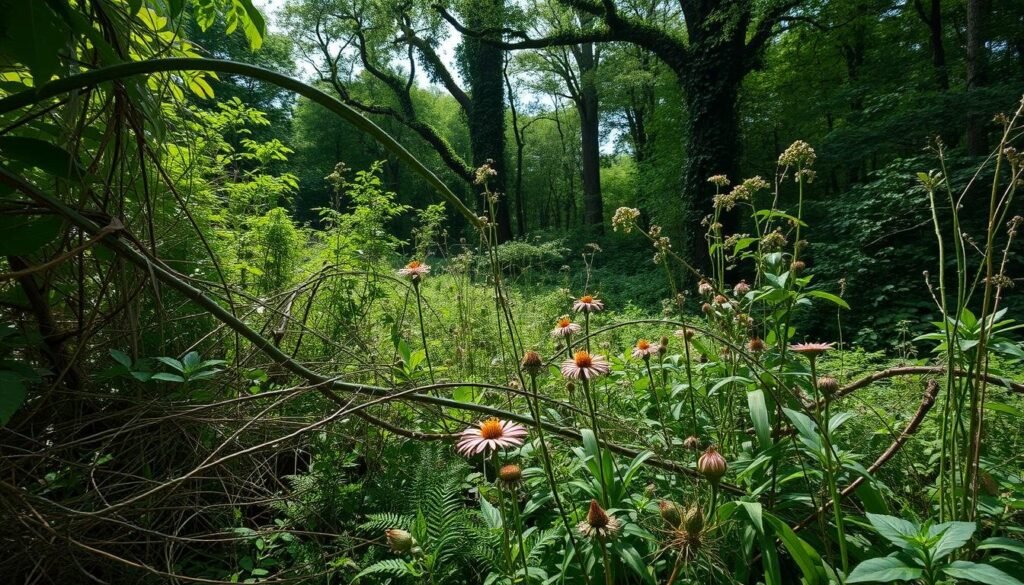Why Invasive Species Threaten the Environment? Have you heard about the harm non-native organisms cause to local ecosystems? It’s more than just a problem; it’s a serious issue. Invasive species are plants, animals, or pathogens that take over native species’ homes and resources, causing a lot of damage.
Looking deeper into this topic, you’ll see the environmental impact is just part of a bigger problem. It also affects the economy and human health. Invasive species can lead to a loss of biodiversity, disrupt food chains, and even cause economic losses in agriculture, forestry, and tourism.
Learning about invasive species and their effects is key to solving the problem. By understanding this issue, you’ll see why conservation efforts are so important. You’ll also learn about the actions being taken to protect our native ecosystems.
Contents
- 1 What Are Invasive Species?
- 2 Why Are Invasive Species Dangerous to the Environment?
- 3 Notable Invasive Species in the United States
- 4 Ecological Impact of Invasive Species
- 5 Economic Consequences of Invasive Species
- 6 How You Can Help Combat Invasive Species
- 7 Conclusion: Why Invasive Species Threaten the Environment?
- 8 FAQ
- 8.1 What are invasive species?
- 8.2 How are invasive species introduced to new environments?
- 8.3 What are some examples of invasive species in the United States?
- 8.4 What is the ecological impact of invasive species?
- 8.5 What are the economic consequences of invasive species?
- 8.6 How can you help combat invasive species?
- 8.7 What is the role of policy and community engagement in preventing the spread of invasive species?
- 8.8 How do invasive species affect native species?
- 8.9 Can invasive species be eradicated?
What Are Invasive Species?
You might not know that invasive species harm the environment, economy, and human health. These are non-native plants, animals, or microorganisms introduced by humans. They compete with native species for resources.
For example, the emerald ash borer has killed millions of ash trees in North America. The zebra mussel clogs water pipes and damages ecosystems. Plants like the kudzu vine and microorganisms like the fungus causing chestnut blight are also invasive.
It’s important to understand what invasive species are and give examples. This helps us see the problem’s size and the need for solutions.
Why Are Invasive Species Dangerous to the Environment?
Invasive species can be a big threat to our environment. They can take over the homes of native animals and plants. This can even lead to some species disappearing forever.
These invaders can change how an ecosystem works. For example, some plants can make fires more likely. Others can upset the balance between predators and prey. This can hurt the variety of life in an area.
They can also cost a lot of money. Like the zebra mussel in the Great Lakes, which has caused big expenses for cleaning and managing. Knowing the risks of invasive species helps us find ways to stop them.
Some reasons why invasive species are harmful include:
- They can outdo native species for food and space
- They can change how ecosystems work, like how nutrients move or fires spread
- They can bring diseases or parasites that native species can’t fight off
- They can alter habitats, making them less good for native species
Understanding these effects shows why we need to control invasive species. We must prevent them, spot them early, and act fast to stop them.
Notable Invasive Species in the United States
Many invasive species are causing trouble in the United States. They harm native wildlife and have big economic costs. Let’s look at some of the most notable ones.
Zebra Mussels and Asian Carp
Zebra mussels and Asian carp are big problems in U.S. waters. Zebra mussels block water pipes and damage boat motors. Asian carp take over food and homes of native fish. Both cause big ecological and economic problems.
Water Hyacinth and Hydrilla
Water hyacinth and hydrilla are invasive plants that block waterways. They make it hard to navigate and harm wildlife habitats. They form thick mats that block sunlight, hurting native plants.
Kudzu and Japanese knotweed are invasive plants that take over. Kudzu damages buildings and infrastructure. Japanese knotweed harms concrete and asphalt.
Emerald Ash Borer and Asian Longhorned Beetle
The emerald ash borer and Asian longhorned beetle are very harmful. The emerald ash borer has killed millions of ash trees. The Asian longhorned beetle attacks many tree types, threatening forests and cities.
Burmese Python and Feral Hogs
Burmese pythons in the Everglades and feral hogs across the country are causing big damage. Burmese pythons eat native wildlife. Feral hogs damage crops and ecosystems.
European Starling and Fire Ants
European starlings and fire ants are invasive and widespread. European starlings compete with native birds. Fire ants cause painful stings and damage crops.
These examples show the variety of invasive species in the U.S. Knowing about them is key to managing their impact.
Ecological Impact of Invasive Species
Invasive species are a big threat to native ecosystems. They can cause a lot of harm. These non-native species can take over, change habitats, and upset the ecosystem’s balance.
One big problem is how they change nutrient cycles. For example, some invasive plants can take more nitrogen than native ones. This changes soil chemistry, helping them grow more. It can hurt other species that rely on native plants.

Invasive species can also mess with water chemistry. They can block waterways and change how water flows. This hurts native aquatic life by reducing light and water quality.
They can also change how native species behave. Some invasive predators can make native prey change their foraging habits. Others can alter where native birds nest. This can lead to fewer native species and even extinction.
The idea of “invasional meltdown” is scary. It means one invasive species can bring in more, speeding up ecosystem damage. Knowing how invasive species affect ecosystems is key to stopping their harm.
Understanding the risks of invasive species helps us take action. We can support conservation and be careful about introducing non-native species. This is crucial for protecting our ecosystems.
Economic Consequences of Invasive Species
It’s key to grasp the economic effects of invasive species to manage them well. These species can cause big losses in forestry, agriculture, and tourism.
The damage from invasive species goes beyond just the harm they do. It also includes the cost of controlling them and fixing the damage. For example, in the U.S., controlling invasive water species costs billions each year.
| Industry | Estimated Annual Loss | Examples of Invasive Species |
|---|---|---|
| Agriculture | $1 billion | Wild pigs, cheatgrass |
| Forestry | $500 million | Emerald ash borer, Asian longhorned beetle |
| Tourism | $200 million | Zebra mussels, Eurasian watermilfoil |
Invasive species also harm the environment, leading to economic losses. They can change water cycles, reduce biodiversity, and mess with nutrient cycles. This has big economic effects.
In summary, invasive species have wide-reaching economic impacts. They affect many parts of the economy. Knowing these effects is crucial for finding ways to stop and manage them.
How You Can Help Combat Invasive Species
Making small changes in your daily life can make a big difference. By being careful about the plants and animals you bring into new places, you can help stop their spread. This is a key way to prevent invasive species.
Start by thinking twice about releasing pets into the wild or adding new plants to your garden. Cleaning your outdoor gear is also important. For example, washing your hiking boots can stop invasive plant seeds from spreading.
If you see an invasive species, it’s important to report it. Many states have programs for this. You can also use apps to report sightings.
Getting involved in your community and supporting policies against invasive species is vital. Joining local clean-up events and learning more about invasive species can help too.
| Action | Impact |
|---|---|
| Be mindful of pets and plants | Prevents introduction of invasive species |
| Clean gear after outdoor activities | Stops the spread of invasive species |
| Report invasive species sightings | Helps in early detection and management |
Conclusion: Why Invasive Species Threaten the Environment?
Invasive species are a big threat to our environment, economy, and society. We need to work together to stop them from spreading and lessen their harm.
Understanding the dangers of invasive species is key. This knowledge empowers you to take steps to fight their spread.
It’s crucial to know the invasive species in your area. Then, you can help stop them from getting in and spreading. You can do this by reporting sightings, supporting conservation, and making eco-friendly choices.
Together, we can lower the risks from invasive species. Your efforts can help keep ecosystems healthy. Every action you take helps protect our environment from these threats.
See Also: Why Square Waves in the Ocean Can Be Dangerous?
FAQ
What are invasive species?
Invasive species are plants and animals that don’t belong where they are. They take over and harm the local ecosystem, economy, and health.
How are invasive species introduced to new environments?
Humans often bring invasive species to new places. This happens through trade, travel, and the pet trade.
What are some examples of invasive species in the United States?
In the U.S., examples include Zebra Mussels and Asian Carp. Also, Water Hyacinth, Hydrilla, Kudzu, Japanese Knotweed, Emerald Ash Borer, and Burmese Python.
What is the ecological impact of invasive species?
Invasive species can change how ecosystems work. They alter nutrient cycles and water chemistry. This can lead to a loss of biodiversity and even “invasional meltdown.”
What are the economic consequences of invasive species?
Invasive species cost a lot to control. They also harm industries like forestry, agriculture, and tourism. This leads to economic losses.
How can you help combat invasive species?
To fight invasive species, be careful what you introduce to new places. Clean your gear and report any sightings.
What is the role of policy and community engagement in preventing the spread of invasive species?
Policy and community action are key. They help by setting rules for handling and moving potentially invasive species.
How do invasive species affect native species?
Invasive species compete with native ones for resources and space. This can lead to a decline in native species and even extinctions.
Can invasive species be eradicated?
Sometimes, invasive species can be removed. But it takes a lot of effort and resources.

Lorenzo Sloan is a safety advocate from Los Angeles who exposes hidden and everyday dangers through research-based blogging. With a background in social work, he aims to keep readers informed, cautious, and prepared for the unexpected risks around them.

